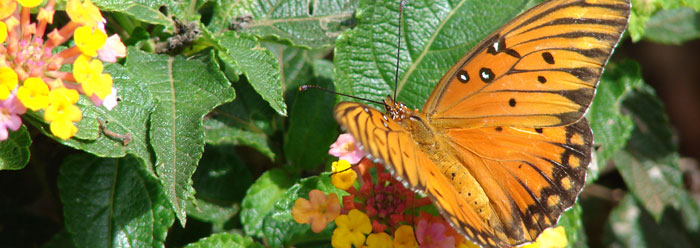Two species of passion-vine butterflies share the same wing patterns and coloring, which some scientists believe provide “some of the most striking examples of adaptation by natural selection.”1 But specifically how these patterns emerged through natural selection has not been worked out in detail. So an international team of scientists sought more specifics by examining the Heliconius butterflies’ genes, and what they found was unexpected.
The researchers compared the genomes of the two Heliconius species to see whether the same genes in each were responsible for the identical wing coloring and patterns. They observed that the butterflies had obviously “undergone rapid speciation and divergence.”2 But the often-touted mechanism for adaptation―natural selection―predicts that variation leading to divergence should develop slowly. It would take a long time for single mutations to be selected out of an interbreeding population, and then for that mutant trait to eventually become fixed into a population.
The speed with which these butterfly wing patterns were expressed in stable populations does not seem to fit the old formula. Instead, the study’s “results imply that despite the many thousands of genes in the genome there are only one or two that are useful for changing this colour pattern.”2
The researchers did not detect many differences among genes that specify core body and cellular processes. Thus, according to co-author Chris Jiggins of the University of Cambridge, “It seems like evolution might be concentrated in quite small regions of the genome―or hotspots―while the rest of it does not change very much.”2 In other words, the key to unlocking a storehouse of wide-ranging variation potential is simply the alteration of just one or two out of many thousands of genes.
The idea may be somewhat new to evolutionary thinking, but this concept has been a theme within creation thinking for a long time. The “hotspots” or keys that unlock certain trait varieties appear to be strategically organized for just that purpose. Also, why would “natural selection,” or any other broadly applicable natural principle, only apply to one or two genes while ignoring the vast majority of the organism’s DNA?
In addition to the passion-vine butterflies, rapid and regulated variation has been observed in dog fur texture,3 dog sizes,4 and other canine breed-defining features.5 Similar patterns were found in African cichlid fish,6 human skull shapes,7 columbine flower colors,8 finch beaks,9 fruit fly development,10 and snail shell sizes.11 In every case, the variation is referred to as “evolution” in the various scientific studies and media reports, but in no case does it follow evolution’s supposed pattern of mutant selection.
Imagine a boulder placed on the edge of a cliff. When tipped over the edge, it breaks into pieces as it strikes obstacles, each piece fragmenting again and again. No resulting fragment will be exactly alike, but all of them share the same chemical essence even though they have lost the original boulder’s potential to express the same wide variety.
In a like manner, passion-vine butterfly wings, and many other visible patterns among life forms, appear to have been set up at one point in time with the potential to diversify, multiply, and fill various environments, while still maintaining their distinct, recognizable types. This speaks to precise engineering, not undirected natural forces.
References
- Counterman, B. A. et al. 2010. Genomic Hotspots for Adaptation: The Population Genetics of Müllerian Mimicry in Heliconius erato. PLoS Genetics. 6 (2): e1000796. See also Baxter, S. W. et al. 2010. Genomic Hotspots for Adaptation: The Population Genetics of Müllerian Mimicry in the Heliconius melpomene Clade. PLoS Genetics. 6 (2): e1000794.
- How the butterflies got their spots. University of Cambridge press release, February 5, 2010.
- Thomas, B. Dog Coat Varieties Come from a ‘Surprisingly’ Elegant Program. ICR News. Posted on icr.org September 8, 2009, accessed March 9, 2010.
- Thomas, B. Small Dogs Came from the Middle East. ICR News. Posted on icr.org March 9, 2010, accessed March 9, 2010.
- Thomas, B. Rapid Variation in Dog Breeds Is 'Regulated,' Not 'Evolved.' ICR News. Posted on icr.org February 2, 2010, accessed March 9, 2010.
- Thomas, B. Cichlid Coloration Corroborates Creation. ICR News. Posted on icr.org October 16, 2008, accessed March 9, 2010.
- Thomas, B. No Evolution Found in Human Facial Differences. ICR News. Posted on icr.org May 1, 2009, accessed March 9, 2010.
- Thomas, B. Flower Color Changes: Evolution or Creation in Action? ICR News. Posted on icr.org July 23, 2009, accessed March 9, 2010.
- Thomas, B. Evolutionary Biologists Rethink Evolution. ICR News. Posted on icr.org February 3, 2010, accessed March 9, 2010.
- Thomas, B. Gene Construction Confirms Creation. ICR News. Posted on icr.org April 17, 2009, accessed March 9, 2010.
- Thomas, B. Snail Changes Outpace Evolution's Slow Crawl. ICR News. Posted on icr.org April 14, 2009, accessed March 9, 2010.
Image credit: Forest and Kim Starr
* Mr. Thomas is Science Writer at the Institute for Creation Research.
Article posted on March 18, 2010.




















